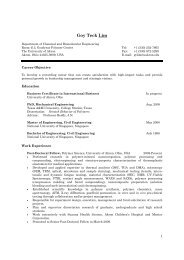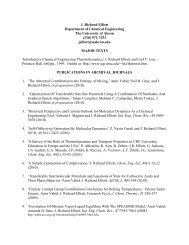Sociology of the Anarchists - Gozips.uakron.edu - The University of ...
Sociology of the Anarchists - Gozips.uakron.edu - The University of ...
Sociology of the Anarchists - Gozips.uakron.edu - The University of ...
You also want an ePaper? Increase the reach of your titles
YUMPU automatically turns print PDFs into web optimized ePapers that Google loves.
McPhail and Wohlstein (1982) give an overview <strong>of</strong> this, and note that:<br />
during ga<strong>the</strong>rings, demonstrations, and riots most<br />
individuals assemble and remain with friends, family, or<br />
acquaintances. Those social units constitute sources <strong>of</strong><br />
instructions and sanctions for <strong>the</strong> individual's behavior... [F]<br />
orms <strong>of</strong> collective behavior are repeatedly observed across a<br />
variety <strong>of</strong> ga<strong>the</strong>rings, demonstrations, and some riots—e.g.<br />
milling, collective focus, queueing, collective locomotion,<br />
and collective vocalization and applause. (pp. 594-595)<br />
Organizational <strong>the</strong>ories (for anarchist organizations)--maybe make into a table??<br />
[Mention Paris (2003) re: black bloc's relevance to “resistance”]<br />
Emma Goldman's “Syndicalism”.<br />
For a more in-depth look at (European) historic anarchist organization (proplatformist?),<br />
please see Skirda (2002).<br />
From Ch5 “Interactions, Groups, and Organizations” <strong>of</strong> Curry, Jiobu, & Schwirian<br />
(2005) (pp. 124-152):<br />
Types <strong>of</strong> interaction: exchange, cooperation, competition, conflict, coercion.<br />
In-group—group to which people feel that <strong>the</strong>y belong (out-group—group to which<br />
people feel that <strong>the</strong>y do not belong).<br />
Primary group—group characterized by intimate, warm, cooperative, and face-to-face<br />
relationships (secondary group characterized by limited participation and<br />
impersonal and formal relationships). See Table 5.1 (Kind, length, scope, purpose,<br />
and typical examples)<br />
Reference group—group whose values, norms, and beliefs come to serve as a standard for<br />
one's own behavior.<br />
Leadership—a person who can consistently influence <strong>the</strong> behavior <strong>of</strong> group members and<br />
<strong>the</strong> outcomes <strong>of</strong> <strong>the</strong> group. Three styles <strong>of</strong> leadership: authoritarian, democratic,<br />
laissez-faire.<br />
Instrumental leader—a group leader whose activities are aimed at accomplishing <strong>the</strong><br />
group's tasks.<br />
Expressive leader—a group leader whose activities are aimed at promoting group<br />
solidarity, cohesion, and morale.<br />
Organization—three characteristics: 1) it is deliberately constructed; that is, someone or<br />
some group <strong>of</strong> people decided to create <strong>the</strong> organization for some purpose. 2) It is<br />
structured, with well-defined roles and positions. Typically, <strong>the</strong> roles differ in<br />
prestige and power. 3) It has rules, and it has sanctions for violations <strong>of</strong> those<br />
rules.<br />
Bureaucracies—a form <strong>of</strong> organization based on explicit rules, with a clear, impersonal,<br />
[ Williams 68 ] [ this is a draft. do not cite. ]






